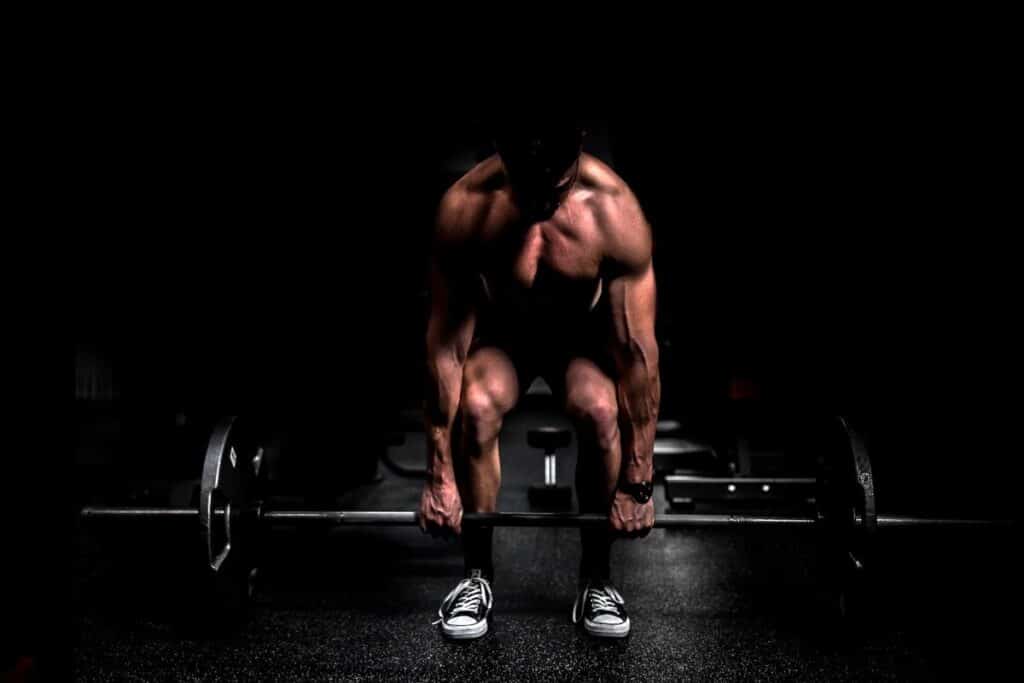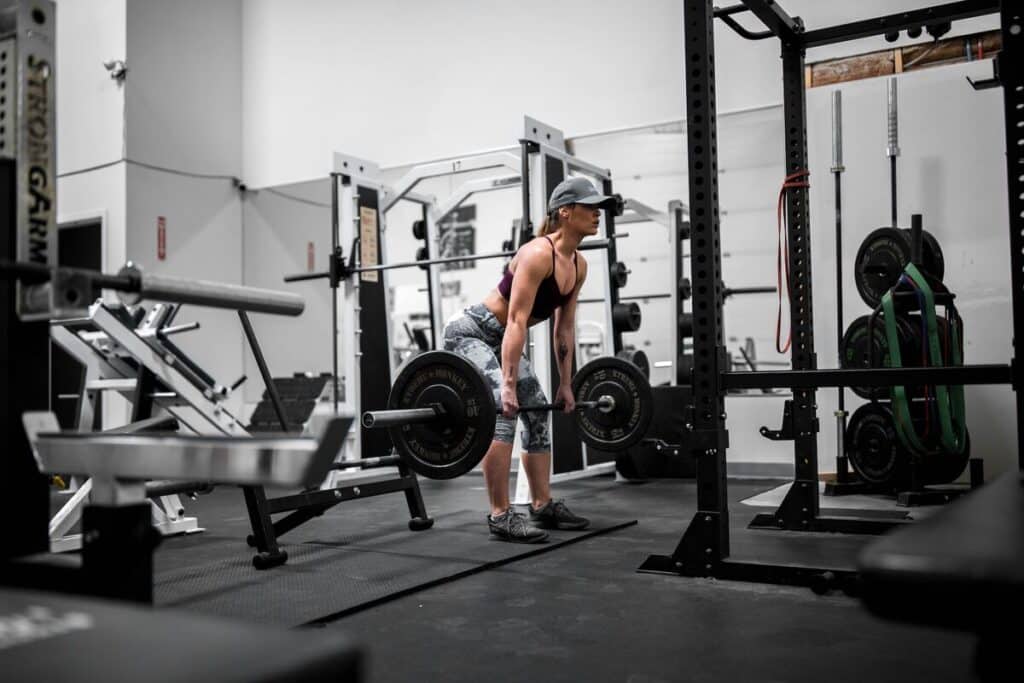As one of the most popular compound exercises in strength training, the deadlift has gained a reputation for being a powerhouse movement that targets multiple muscle groups simultaneously. In this comprehensive guide, we will explore the muscle groups involved, the proper form and technique, and the benefits of this exercise.
In this article
What muscles does a deadlift work? The deadlift primarily targets the posterior chain, including the erector spinae muscles of the lower back, the gluteus maximus muscles of the buttocks, and the hamstrings in the back of the thighs. Additionally, it also engages other muscle groups such as the quadriceps, gastrocnemius and soleus muscles of the calves, and the upper back muscles, including the traps and rhomboids.

What key muscle groups do deadlifts work?
The deadlift is a compound exercise that engages multiple muscle groups, making it a highly effective strength training exercise. The key muscle groups worked in a deadlift include:
- Gluteus maximus: The traditional deadlift primarily targets the gluteus maximus, which is the largest muscle in the buttocks and plays a significant role in hip extension and overall lower body strength.
- Hamstrings: The hamstrings, located at the back of the thighs, are also heavily engaged in a deadlift. They work dynamically to help flex the knees and hips as you lift the weight.
- Quadriceps: The quadriceps, located at the front of the thighs, stabilize the body and help with knee extension during a deadlift.
- Erector spinae: The erector spinae muscles, located along the spine, are responsible for maintaining a stable spine and posture during the deadlift exercise.
- Trapezius: The trapezius, a large muscle that extends from the base of the skull to the mid-back, is also engaged in a deadlift. It plays a role in stabilizing and retracting the shoulder blades during the movement.
- Core muscles: The muscles of the core, including the abdominals, obliques, and lower back muscles, are activated during a deadlift to provide stability and support to the spine.
- Adductor Magnus: The adductor magnus, located in the inner thigh, is also worked during a deadlift, particularly in the sumo deadlift variation.

What are the benefits of deadlifts?
The deadlift is a compound exercise that offers numerous benefits for overall strength and fitness. Some of the key benefits of deadlifts include:
1. Full-Body Activation
Deadlifts engage multiple muscle groups in the body, including the glutes, hamstrings, quadriceps, erector spinae (the muscles along the spine), core, and trapezius muscles, making it a highly effective full-body exercise.
2. Increased Strength
Deadlifts are known for their ability to increase strength, especially in the lower back, hips, and legs. Regular deadlift training can help improve functional strength and performance in other exercises and daily activities.
3. Improved Posture and Core Strength
It requires proper form and technique, including maintaining a flat back throughout the movement. This helps strengthen the core muscles, including the abdominal muscles and lower back muscles, which can improve posture and stability in everyday activities.
4. Enhanced Fat Burning
It can also contribute to weight loss and improved body composition, as they are a highly demanding exercise that burns a significant amount of calories and stimulates the metabolism.
5. Release of Anabolic Hormones
Deadlifts are a compound movement that can trigger the release of anabolic hormones, such as testosterone and growth hormone, which are important for muscle growth and repair.
6. Better Athletic Performance
It can improve overall athleticism, as they require coordination, balance, and strength. Deadlifts can enhance performance in other sports and physical activities that require explosive power and strength from the lower body and core.
7. Increased Bone Density
Deadlifts are a weight-bearing exercise that can help increase bone density, which is important for overall bone health and reducing the risk of osteoporosis.
8. Time Efficiency
It is a compound exercise that targets multiple muscle groups in a single movement, making them a time-efficient option for a full-body workout.
What are the different variations of deadlifts?
Deadlifts, a popular compound exercise that targets multiple muscle groups, have several different variations that can provide unique benefits and challenges. Here are some of the common deadlift variations:
Conventional Deadlift
This is the standard deadlift variation where you lift a weighted barbell from the floor using a shoulder-width grip and a neutral spine position.
Romanian Deadlift (RDL)
Also known as the Stiff-Leg Deadlift, the RDL involves keeping your legs straight or slightly bent and focusing on hinging at the hips while maintaining a neutral spine position. This variation places more emphasis on the hamstrings and glutes.
Sumo Deadlift
In this variation, your feet are placed wider than shoulder-width apart, and your toes are pointed outward. The grip is inside the knees, and the movement involves a wider stance and a more upright torso position, targeting the inner thighs and placing less stress on the lower back.
Trap Bar Deadlift
This variation uses a special hexagonal barbell that allows you to stand inside the bar and grip it from the sides. This can be more joint-friendly and may place less stress on the lower back compared to the conventional deadlift, making it a good option for beginners or those with lower back issues.
Snatch Grip Deadlift
This variation involves using a much wider grip, similar to that used in Olympic weightlifting. This places more emphasis on the upper back, traps, and grip strength, and requires greater mobility and flexibility.
How much should you deadlift?
The number of deadlifts you should do depends on several factors such as your fitness level, training goals, and experience with strength training. Deadlift frequency can vary from 2 to 5 times per week, depending on the training program and goals.
Some programs, like StrongLifts 5×5, may have only one deadlift workout per week, while others, like Smolov squat training, may incorporate heavy deadlifts as needed for this lifting technique.
In terms of rep ranges, it is generally recommended to keep the total reps of working sets under 30 and to decrease the number of reps as intensity increases. For example, including 4-5 working sets of 3-6 reps is a common approach for deadlift training.
However, the ideal rep range may vary depending on factors such as training experience, goals, and recovery capacity. It’s advisable to consult with a qualified fitness professional or strength coach to determine the appropriate rep range for your specific needs.
How to do a deadlift
Here’s a simple step-by-step tutorial on how to do a deadlift:
1. Set up your stance and grip
- Stand with your feet shoulder-width apart, angled slightly outward.
- Bend at the hips and grip the barbell with both hands at shoulder width, using a mixed grip (one hand overhand, the other hand underhand).
2. Position your body
- Bend your knees until the barbell is almost touching your shins, while keeping your spine in a neutral position.
- Ensure your elbows are just touching the outside of your legs, and your grip is firm on the barbell.
3. Prepare for the lift
- Flex your glutes and brace your core to engage your abdominal muscles and stabilize your spine.
- Take a deep breath and hold it to create intra-abdominal pressure for added stability.
4. Lift the weight
- Keeping your back straight and your chest up, drive through your heels to stand up straight, lifting the barbell off the ground.
- As you lift, focus on using your legs and glutes, and avoid rounding your back or jerking the weight up.
5. Lower the weight
- Lower the barbell back down to the ground by hinging at the hips and bending your knees, while maintaining a neutral spine.
- Keep the weight close to your body throughout the movement to maintain control and stability.
Safety precautions when doing deadlifts
Safety is crucial when performing deadlifts to prevent injuries. Here are some safety precautions to keep in mind:
1. Maintain proper form
It’s essential to use proper form when performing deadlifts to minimize the risk of injury. This includes keeping your back straight and rigid throughout the lift, avoiding rounding of the back, and bending your knees about 30 degrees.
2. Start with lighter weights
If you’re new to deadlifting or are returning after a long break, start with lighter weights and gradually increase the weight as you gain strength and confidence in your form. Avoid lifting weights that are too heavy for you, as it can increase the risk of injury.
3. Warm up properly
Before starting your deadlift workout, make sure to warm up properly by performing some dynamic stretches and exercises that target the muscles you’ll be using during deadlifts. This helps to increase blood flow to the muscles, improve flexibility, and reduce the risk of muscle strains or pulls.
4. Use a suitable weightlifting equipment
When performing deadlifts, it’s important to use a standard 45-pound barbell or other suitable weightlifting equipment. Avoid using makeshift or improper equipment that can compromise your safety.
5. Take breaks and rest
Deadlifts can be physically demanding on your muscles and central nervous system. It’s important to take breaks and allow yourself enough rest between sets to prevent fatigue and reduce the risk of injury.
Frequently Asked Questions (FAQs)
Got more questions? Check out some commonly asked questions about deadlifts and the key muscle groups they work.
The deadlift primarily targets the posterior chain muscles, including the muscles of the lower back, glutes, and hamstrings, along with secondary engagement of the quadriceps, calves, and upper back muscles.
Yes, there are variations of deadlifts such as the sumo deadlift, Romanian deadlift, and trap bar deadlift, which may emphasize slightly different muscle groups or shift the focus to specific areas such as the inner thighs, hamstrings, or traps.
Absolutely! Deadlifts are considered a compound exercise that targets multiple muscle groups simultaneously, making them an effective exercise for overall strength and muscle development. Incorporating deadlifts into your fitness routine can help improve your performance in other exercises and promote overall functional fitness.
Final Word
By targeting the posterior chain and engaging multiple muscle groups simultaneously, deadlifts can help you build overall strength, increase muscle mass, and improve functional fitness. If you found this article helpful, don’t hesitate to share it with a friend. And be sure to check out my full blog for more tips and insights on fitness and health. Remember, consistency and dedication are key to achieving your fitness goals, so keep pushing yourself and enjoy the journey to a stronger and healthier you!
